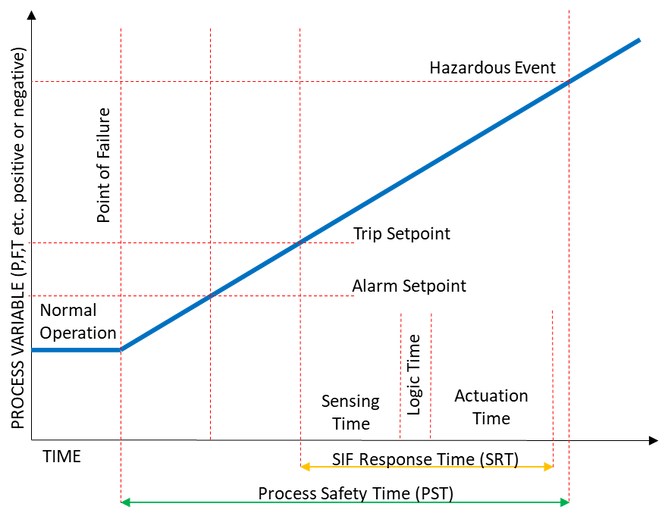Safety Instrumented Systems (SIS) need to ensure that the response time of a Safety Instrumented Function (SIF) protecting a specific hazard, responds in sufficient time to mitigate the hazard. The process safety time should be developed during process design. This value is documented in the Safety Requirements Specification (SRS). SIF design should include calculation of the SIF Response Time (SRT) taking sensing element, logic solver and actuation time into account. The rate of hazardous event development should be considered and documented by the process design. The graph below assumes a linear development but often this may be exponential.
Process Safety Time (PST):
How fast does the failure event develop? This is taken from the moment a valve or controller fails to the hazardous event occurring. This time is a function of the process and depends on the equipment volumes, flow rates, compositions, and valve sizes.
SIF Response Time (SRT):
How long does the SIF have to respond? This is shorter than the process safety time. It is a performance target that the SIF needs to meet and is a function of the speed of detection, logic processing and final element completion. It represents the length of time available between the SIF set-point being reached and the hazardous event being mitigated.
Sensing Time:
This is the time the sensor takes to determine that the process setpoint has been reached. For example, a typical vibrating fork level switch could operate in milliseconds. On the other hand, a guided wave radar transmitter may take seconds to respond depending on the filtering that has been applied.
Logic Time
This is the time the logic system takes to make the decision, including input module conversion, logic module processing and output module state change. Typically, this in the order of milliseconds.
Actuation Time
This is the time taken by the actuator to achieve the safe state. Here consider valve closing times, pump/motor stopping times etc. This is usually the most dominant value in the SRT, some large valves could take multiple seconds to close.



